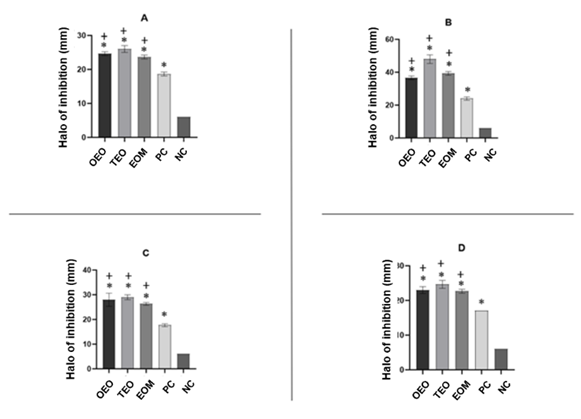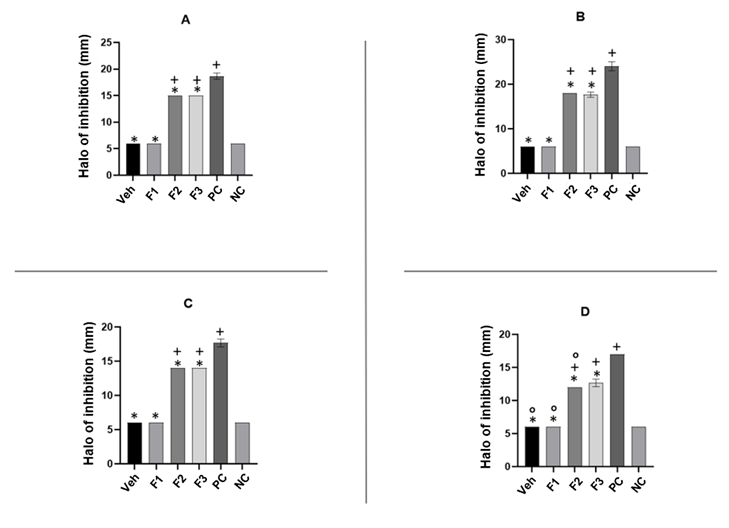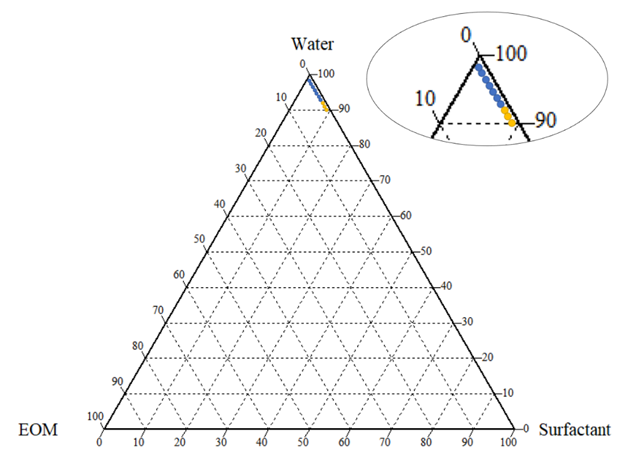Introduction
Periodontal disease (PD) is one of the most common conditions that affect canines' oral cavity (1). Chronic PD is manifested by an overgrowth of anaerobic bacteria, mostly Gram-negative, at subgingival sites. It is described as the infection and inflammation of the gums, bones, and other tissues surrounding and teeth supporters. Temperature, humidity, and irregularities in the canine oral cavity facilitate the proliferation of the microorganisms, also, the lack of oral hygiene habits and constant cleaning. (2).
In Bogotá, Colombia, the Zoonosis Center has reported that nearly 64% of animals are affected by PD, and approximately 16% of those animals suffer both caries and PD (3). Moreover, in the US, PD prevalence is close to 80%, and although prevalence rates vary between studies, PD is usually one of the most common diseases that affect canines (2).
As for PD treatment, some chemical agents have been used to help control bacterial plaque, for example, benzalkonium chloride, cetylpyridinium chloride, and essential oils that contain phenol, thymol, carvacrol, and eucalyptol. Chlorhexidine (CLX) is also on the list of the most used chemical agents due to its antibacterial action against a wide range of aerobic and anaerobic bacteria (4). Besides, oregano essential oil (OEO) and thymus essential oil (TEO) have been associated with an important antimicrobial activity against Gram-positive and Gram-negative bacteria due to the presence of carvacrol, thymol, and α-terpene (5).
Microemulsion preparations are a strategy for incorporating essential oils, such as OEO and TEO, into aqueous-based formulations. Microemulsions are colloidal dispersions of water, oil, and surfactant, which are transparent, monophasic, thermodynamically stable, with very low interfacial tension and low viscosity. Its formation is spontaneous, and the dispersed droplets have a diameter in the 1 to100 nm range, usually 10 - 50 nm (6,7).
In Costa Rica, the supply, availability, and access to canine oral hygiene products recommended as a preventive PD treatment is scarce. Therefore, the present study's main objective was to formulate and evaluate the antimicrobial activity of a 0.2% chlorhexidine canine mouthwash with oregano and thyme essential oils.
Materials and methods
Essential oils
Origanum vulgare essential oil (OEO) (lot 183554) and Thymus vulgaris essential oil (TEO) (lot 190219) were purchased from doTERRA International, San José, Costa Rica. According to the quality analysis certificates provided by the Aromatic Plant Research Center (https://aromaticplant.org/), the OEO contained 1.4% thymol and 72.1 % carvacrol, and the TEO contained 59.1% thymol and 3.1% carvacrol. The formulations were prepared as an essential oil mixture (EOM) composed of 85.7 % OEO and 14.3 % TEO.
Emulsifier selection
The EOM miscibility with different surfactant agents was evaluated because OEO and TEO's required-HLB values were unknown. The evaluated surfactant agents were hydrogenated castor oil, Tween 80, Span 65, PEG 400, and PEG 400 combined with hydrogenated castor oil (50:50).
The surfactant agents were mixed with the EOM (1 part of EOM in 2 parts of surfactant). The selected emulsifier must guarantee the EOM complete miscibility; in this case, hydrogenated castor oil was the best surfactant option.
Construction of pseudo-ternary phase diagram
In the construction of the pseudo-ternary phase diagram, the EOM was considered the oil phase; distilled water was the aqueous phase; and the surfactant agent was the hydrogenated castor oil, based on the emulsifier selection results.
The surfactant and aqueous phase were mixed in a specific ratio (1:99 to 10:90) in different vials. The EOM was added in a fixed proportion to guarantee OEO and TEO's minimum inhibitory concentration. Table 1 data was used to construct the ternary phase diagram.
The pseudo-ternary phase diagram mixtures were evaluated by visual inspection, and the non-opaque mixtures were selected as the possible microemulsion formulation. In the selection among non-opaque mixtures, the lowest amount of surfactant added was considered.
Table 1 Composition of the pseudo-ternary phase diagram mixtures.
| Mixture | EOM (%) | Surfactant (%) * | Water (%) |
|---|---|---|---|
| S1 | 0.4 | 1.2 | 98.4 |
| S2 | 0.4 | 2.1 | 97.5 |
| S3 | 0.4 | 3.1 | 96.5 |
| S4 | 0.4 | 4.1 | 95.5 |
| S5 | 0.4 | 5.2 | 94.5 |
| S6 | 0.4 | 6.5 | 93.1 |
| S7 | 0.4 | 7.2 | 92.4 |
| S8 | 0.4 | 8.2 | 91.4 |
| S9 | 0.4 | 9.3 | 90.3 |
| S10 | 0.4 | 10.4 | 89.2 |
*The surfactant agent was the hydrogenated castor oil, based on the emulsifier selection results.
Preparation of microemulsion formulations
The mixture S10 from the pseudo-ternary phase diagram was selected as the starting point for the canine mouthwash formulation. It was optimized to reach the desirable characteristics by adding and incorporating different excipients such as preservatives, viscosity enhancers, pH-adjusting agents, and flavoring agents. Preservatives (parabens) were added to avoid microbiological contamination, sodium carboxymethylcellulose (CMC) used as a viscosity enhancer, and NaOH as pH-adjusting agent. The flavoring agent was added to improve the formulations' organoleptic properties because it is designed to be administered by the oral route. In addition to the EOM, chlorhexidine (CLX) was added to the formulations as an active ingredient.
Evaluation of the antimicrobial activity of essential oils and formulations
The antimicrobial activity evaluation of essential oils and formulations was carried out in the Microbiology Faculty at the Universidad de Costa Rica. The antimicrobial activity was determined by the disk diffusion test (8).
The strains Staphylococcus aureus ATCC 25923, Streptococcus mutans ATCC 35668, S. salivarius ATCC 13419, and Escherichia coli ATCC 25922 were used for the antimicrobial activity evaluation. Chlorhexidine 0.2% (distilled water as solvent) was a positive control (PC), and sterile water was the negative control (NC).
In the first instance, the OEO, TEO, and EOM were evaluated. The essential oils alone or in combination were filtered through a 0.22 µm membrane filter and, by triplicate, 40 µL of each sample was placed in 6 mm diameter wells. Blood agar plates were incubated at 37 °C for 48 hours, and halos of inhibition were measured.
After the antimicrobial activity confirmation of OEO, TEO, and EOM, the vehicle (formulation without active ingredient) and the formulations in Table 2 were evaluated by the method described before using the mentioned strains. All the antimicrobial activity results are expressed as mean ± SEM.
Results
Emulsifier selection
The surfactants hydrogenated castor oil, Tween 80, Span 65, PEG 400, and PEG 400 combined with hydrogenated castor oil (50:50) were evaluated. Mixing EOM with hydrogenated castor oil allowed the complete miscibility between both components. The final solution was clear, and a one-phase system was observed. Mixing EOM with Tween 80, Span 65, PEG 400, or PEG 400 combined with hydrogenated castor oil (50:50) resulted in an opaque mixture. Also, after 4 hours resting period, the mixtures formed a two phases system.
Construction of pseudo-ternary phase diagram
The pseudo-ternary phase diagram is shown in Figure 1. Mixtures S8, S9, and S10 formed a clear microemulsion with low agitation energy. All the samples were maintained at room temperature for 48 hours, and after the resting period mixtures, S1-S7 developed a two-phase system, while mixtures S8-S10 remained in a microemulsion system.
Preparation of microemulsion formulations
The mixture S10 from the pseudo-ternary phase diagram construction was the starting point formulation. The chlorhexidine (CLX) was added to S10 in an amount equivalent to 0.2 % of the total formulation weight, while EOM concentration was 0.4 %, the needed concentration to guarantee the minimum inhibitory concentration of OEO and TEO.
Preservatives, pH-adjusting agents, viscosity enhancers, and flavoring agents were included in the initial microemulsion to formulate a canine mouthwash with the right organoleptic properties to be administered by the oral route. The different microemulsion formulations were developed to adjust the viscosity, pH value, and flavor. Sodium carboxymethylcellulose (CMC) was used as a viscosity enhancer and as a mucoadhesive agent to increase the oral cavity's product permanence. The formulations' acidity was adjusted to pH 8.55 because they were designed to be applied in the canine oral cavity, ranging between 8.50 and 8.65. Finally, the preservatives used in formulations were parabens, which are active in a wide pH range.
Three possible formulations were obtained (Table 2). The differences between those formulations were the active pharmaceutical ingredients: F1 only contained the EOM, F2 contained CLX 0.2 %, and F3 contained EOM and CLX 0.2 %.
Table 2 Composition of the possible mouthwash formulations.
| Formulation | Excipients (% w/w) | Active ingredients (% w/w) | ||||||
|---|---|---|---|---|---|---|---|---|
| Surfactant (hydrogenated castor oil) | CMC | Preservatives (parabens) | NaOH 1M | Flavoring agent | Water | EOM | CLX | |
| F1 | 10,4 | 0,1 | 0,1 | 0,4 | 4,2 | q.s. 100 | 0,4 | - |
| F2 | 10,4 | 0,1 | 0,1 | 0,4 | 3,0 | q.s. 100 | - | 0,2 |
| F3 | 10,4 | 0,1 | 0,1 | 0,4 | 4,2 | q.s. 100 | 0,4 | 0,2 |
| Vehicle | 10,4 | 0,1 | 0,1 | 0,4 | 4,2 | q.s. 100 | - | - |
Antimicrobial activity evaluation of essential oils and formulations
The antimicrobial activity evaluation of OEO, TEO, and EOM is shown in Figure 2. The bacterial growth inhibitory effect of essential oils, alone and in combination, was higher than the NC, thus demonstrating the OEO, TEO, and EOM's antimicrobial activity. Also, the essential oils' antimicrobial activity was more elevated than CLX 0.2 %, the PC. OEO and TEO were evaluated alone and combined due to the possibility of a synergic effect between them; however, it was not observed.

Source: self made
Figure 2 Evaluation of the antimicrobial activity of essential oils. (A) S. aureus, (B) S. mutans, (C) S. salivarius, (D) E. coli. * p <0.05 compared to NC; + p <0.05 compared to PC. Veh: vehicle (formulation without active ingredient), F1: Formulation 1 (essential oil mixture as the active ingredient), F2: Formulation 2 (chlorhexidine as the active ingredient), F3: Formulation 3 (essential oil mixture plus chlorhexidine as active ingredients), PC: Positive control, NC: Negative control.
The antimicrobial activity evaluation of vehicle and microemulsion formulations is shown in Figure 3. The bacterial growth inhibitory effect of vehicle and F1 was zero, the same value that NC. The antimicrobial activity of F2 and F3 was lower than PC but higher than NC. There is a possibility that the formulation excipients decrease the antimicrobial activity of CLX and EOM.

Source: self made
Figure 3 Evaluation of the antimicrobial activity of vehicle and microemulsion formulations. (A) S. aureus, (B) S. mutans, (C) S. salivarius, (D) E. coli. * p <0.05 compared to PC; + p <0.05 compared to NC; ° p <0.05 compared to F3. Veh: vehicle (formulation without active ingredient), F1: Formulation 1 (essential oil mixture as the active ingredient), F2: Formulation 2 (chlorhexidine as the active ingredient), F3: Formulation 3 (essential oil mixture plus chlorhexidine as active ingredients), PC: Positive control, NC: Negative control.
Discussion
A canine mouthwash was developed as a microemulsion formulation using chlorhexidine (CLX), thymus essential oil (TEO), and oregano essential oil (OEO) as active pharmaceutical ingredients. CLX is one of the most used chemical agents recommended for periodontal disease prevention, and it has been used as an antiseptic in mouthwashes, toothpaste, and oral hygiene products (9, 10, 11). This agent reduces biofilm formation by altering bacteria's adhesion to teeth and gingival tissues and disrupts the bacterial cell membrane increasing cell permeability (4).
The main components of OEO and TEO are carvacrol, thymol, and α-terpene (5). Carvacrol is a non-toxic monoterpene, widely studied for its pharmacological properties such as antibacterial and antifungal activities (12). Thymol and carvacrol mechanisms of action are similar. In Gram-negative bacteria, the cell permeability increases, and the membrane stability decreases due to the membrane disruption and lipopolysaccharides release. In Gram-positive bacteria, thymol binds to membrane protein hydrophobic residues by hydrogen bonding, increasing the cell permeability (13).
OEO, TEO, and CLX have been formulated as microemulsions to treat different diseases (14, 15, 16, 17). In this investigation, we propose a canine mouthwash formulation as a microemulsion system. Microemulsions are dispersions of water, oil, and surfactants that are monophasic systems, thermodynamically stable with a long shelf life, low cost, low viscosity, and clear appearance. One of the major advantages of microemulsions is their formation process; it is spontaneous and self-assembly, reducing production cost and time (6,7).
The canine mouthwash formulation was developed as a stepwise process. In the first place, the essential oils' miscibility with different surfactants was evaluated since the required-HLB value of essential oils was unknown. This study suggests that the best emulsifier agent for the EOM and the mouthwash formulation was hydrogenated castor oil because it guarantees the EOM and CLX complete miscibility and stability. Besides, hydrogenated castor oil is a low cost and low toxicity surfactant agent, desirable properties for excipients selection (18).
Once hydrogenated castor oil was selected as an emulsifier agent, a ternary phase diagram was constructed. Ternary phase diagrams offer information about the thermodynamically stable phases of a three-component system under specific conditions (19) and are considered a tool in microemulsion formulations development (14, 15, 16, 17, 20). In this case, the EOM was the oil phase, distilled water was the aqueous phase, and the surfactant agent was the hydrogenated castor oil. Figure 1 shows three one-phase mixtures with a clear and non-opaque appearance; the microemulsion's spontaneous formation was observed during the mixing process. Large amounts of energy were not required, only a slight agitation to facilitate the process. For this reason, those mixtures were considered microemulsions (6, 14). Microemulsion systems allow the essential oils' complete dispersion and can be used as a stable and low-cost formulation strategy (14, 15, 17).
The mouthwash formulations were developed using the ternary phase diagram's microemulsions, and the CLX inclusion was the defining step process to select the best microemulsion mixture for the mouthwash formulation. Although three microemulsion mixtures were obtained (Figure 1), only S10 allows the CLX 0.2 % addition. The formulation included different excipients, such as preservatives, pH-adjusting agents, viscosity enhancers, and flavoring agents. The objective was to improve and optimize canine mouthwash organoleptic properties according to the canine oral cavity requirements and characteristics (18).
The antimicrobial activity evaluation of mouthwash formulations indicates that despite EOM is related to a higher bacterial growth inhibitory effect than CLX 0.2% (Figure 2), in the formulation containing EOM (F1), the inhibition of bacterial growth disappears (Figure 3). Usually, essential oils' activity in microemulsion systems can be affected by the oil phase composition, and emulsifier quantity and structure (14); and taking into consideration that the essential oils final concentration was the minimum inhibitory concentration reported in the literature, i.e., 0.690 mg/mL for OEO and 0.062 to 0.500 mg/mL for TEO (21, 22). Incompatibilities between active ingredients or the use of sub-therapeutic concentrations of essential oils may reduce the antimicrobial activity (23). Another possible reason for the absence of antibacterial activity in F1 could be the formulation pH because TEO's effect is more significant at lower pH values. Some of the TEO components are not dissociated in acid media, facilitating bacterial membranes' disruption (13).
On the other hand, F2 containing 0.2% CLX and excipients showed a lower inhibition of bacterial growth than the positive control (0.2% CLX in water). That difference in the antimicrobial activity might be to the presence of a nonionic surfactant in the formulation since it reduces the CLX activity (24).
Despite F2 and F3 antimicrobial activity decrease compared to the positive control, results suggest that both formulations are an alternative to decrease the bacterial growth of the main bacteria associated with periodontal disease in dogs. A strategy to improve the formulation could be increasing the concentrations of the essential oils.















